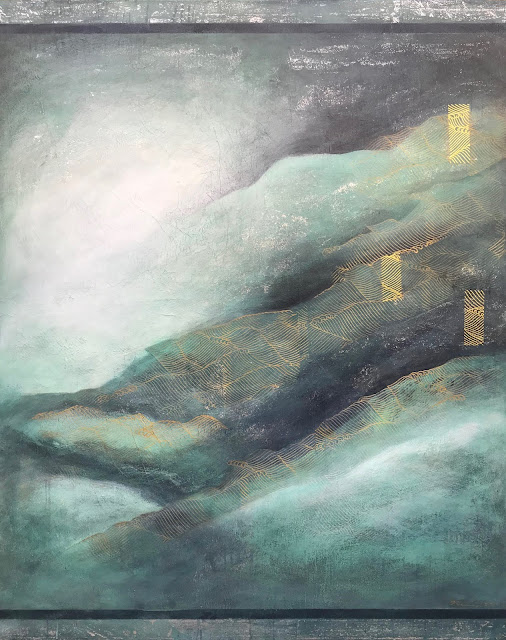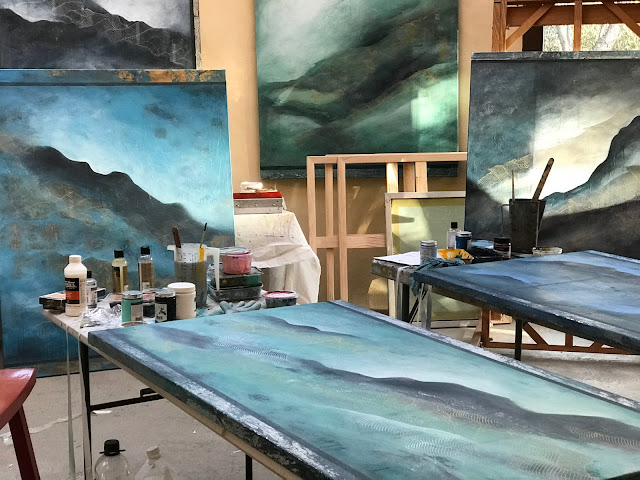“To send light unto the darkness of men’s hearts. Such is the role of the artist” - Robert Schumann
Art
Art was once the handmaiden of religion, culture and philosophy. It offered the viewer an enlarged vision and spiritual stimulation. The role of art in almost every pre-industrial culture was to depict the sacred and was valued as a developing force within man. The function of art was to free the spirit of the beholder and to invigorate and enlarge his or her vision.
Ever since I was young, I’ve held an interest in the spiritual life of man - rather than the mundane world of things. As a child I would often contemplate the idea of existence, the source of all life and of imagined worlds beyond ours. I was fascinated with philosophy, wisdom and spiritual traditions across the globe and intrigued by the symbolism within the artwork that assisted in communicating these teachings. It was fascinating to observe how artistic imagery spread across the globe as it’s associated religion and philosophy was shared. I also loved to learn that in many cultural traditions, that the artist was considered a highly spiritual member of society and would often work closely with the priests, shamans, lamas or holy-men in order to visually translate spiritual concepts to the wider community.
Creating in Kindergarten
As a 7 year old, I also dreamed of becoming an artist. In early primary school when asked to dress up as ‘what you would like to be when you grew up’, I found an art smock, beret and some brushes and a wooden palette that belonged to my dad’s dad who was indeed an artist.
It’s fascinating how ones dreams and values are so clear at such a young age. I’ve also always perceived my artistic expression as a means to uplift inspire the viewer. Over the decades I’ve been drawn to number of cultures who’s philosophies and art forms, can offer us, here in the West, wisdom of how we can perhaps relate to our planet and each other in a more balanced way.
‘Self Portrait’ by an individual in an Art Therapy session.
Art Therapy
Around 20 years ago I enrolled in my first ‘Art Therapy’ course with the dream to combine my two big callings, ‘art’ and ‘helping others’.
….. And now, having spent over 15 years of practicing as an Art Therapist, I have sat with many more than 20,000 (crazy when you add it up) individuals, encouraging them to make meaning of their life experience through the medium of visual art. As one could imagine, working with individuals in settings such as drug and alcohol detoxes, rehabs, homeless shelters and stress & depression clinics, the stories lived and the pain that has been suffered are ‘big’, to say the least.
To share sessions discussing the meaning of life, the blessings that suffering offers and gently reconnecting with inner wisdom, strength and courage is a great gift.
In the safety of a therapeutic setting, it has been an incredible honour to hold the hand of another individual and to encourage them to lean towards their suffering, rather than to move away from it. To turn to face the shadow, rather than to numb, run from or distract from the experience of pain and discomfort.
While my own solitary artistic practice has been a constant source of rejuvenation after holding the space for some of these cathartic experiences in others, I have consciously kept my art and art therapy quite separate.
Before now I’ve also held the position that I don’t want my paintings to be about me. No offense to others who find their artistic practice a great source of personal therapy, but I’ve felt it somewhat self-absorbed, and shallow to center an exhibition of work on egoic self concern. Don’t get me wrong, I use art therapy frequently as a means of processing my own experience and I have volumes of artwork that captures some of the ‘not so pretty’ expressions from those inner wounds that need balancing. To me though, these have always been personal.
It wasn’t until last year that the bridge between my art and art therapy practice became solidified.
Studio Session
Art and Art Therapy
On a personal level, this had been perhaps the hardest year of my life. Just as two of my closest friends lost their battle with cancer, my intimate relationship also dissolved. Now I had to experience intense suffering. My whole world of ‘what I had come to know’ crumbled. Waves of tumult, grief, intense loss, fear and sadness left me open, raw and vulnerable. Now it was my turn. Just as I had encouraged others to ‘lean into’ their unpleasant feelings, I knew that I must now ‘practice what I preach’.
I decided to make it my spiritual practice to sit with all of the feelings that every part of me wanted to run from. From somewhere deep inside, I knew that this period of such enormous pain must be one of those ‘big life lessons’ that in time would possibly transform me and catapult me into a new experience. That same inner voice knew that this was a priceless opportunity and I made the commitment to make each decision and take each action from a place of honour. To consciously choose the ‘high road’.
“Beyond the Veil of Darkness”. This work responds to the inherent beauty below the emotional realm of human experience. Rather than moving away from uncomfortable or painful emotions, this work suggests a leaning into the tumult and storm. Having pierced the veil of initial resistance, the wisdom, beauty, depth and clarity that life offers in every moment can be experienced more fully.
New Work
This new series of paintings reflects this new commitment to hold a space to process the emotional fallout from such a huge life experience.
As I am beginning to slowly unveil this new body of paintings to the world, I notice that viewers really appreciate my openness and vulnerability in exploring those ‘uncomfortable moments’ that we all experience. This body of work responds to the transformation that occurs when we are courageous enough to move toward and dive into the stormy seas, rather than our natural response, to move away from and to avoid, numb or escape.
There has been so much research conducted on emotional pain. Researcher Dr Joan Rosenberg (who has a fabulously inspiring Ted talk on this very topic!) has found that the unpleasant feeling that is experienced in the body as a result of an emotion only lasts between 60-90 seconds and that if we learned how to ‘ride this wave’ of the uncomfortable, the wave then recedes and the individual is left with a sense of more self worth, pride and strength. Sadly, suppressing these emotions brings the opposite.
“Consistently distracting or avoiding what is unpleasant and uncomfortable is, unfortunately, the start of the slow trek to increased anxiety, bodily pain, vulnerability and disempowerment’ - Dr Joan Rosenberg.
It’s my hope that individuals may embracing the opportunity to reflect on their own emotional world more deeply while contemplating the paintings in this new series. I’d love to invite the viewer on an imaginary journey to ride the waves and penetrate the layers of emotion and thought in their own inner world (allowing the harshness to soften, the clouds to dissipate and the drama to dissolve). Finally coming to rest in the space and silence, once again connected to the still background presence that never left.
“Fall into Grace” - To fall from grace is to lose favour or a position of power. Not surprisingly the term ‘the fall of man’ stems from Christianity, and with it threatens that if mankind disobeys religious dogma, he will fall from honour and respect. Even though the grip that Christianity once held on society is dissolving, it’s interesting to notice the subtle beliefs that are still conditioning our experience of life in this modern day. We’re taught to strive towards success, status, fame, wealth, prestige and power - and in the modern culture, to lose our status in society is to ‘fall from grace’. Yet, isn’t this another of life’s great paradoxes - to ‘fall’ from the surface illusion of power or ego is to actually drop into the deeper presence and ‘grace’ beneath all mental constructs... to surrender to life, to connect with the whole, to fall INTO grace
“Imagine you are a lake… the surface of the lake changes according to weather, wind, rain etc. But the depth of the lake remains always undisturbed.” - Eckhart Tolle
I am inspired to relay this quote frequently when working with individuals in a therapeutic context, however this simple visualization is so helpful in my own personal practice of remaining connected to my depth and stillness beneath any turbulent life situation.
I am inspired to relay this quote frequently when working with individuals in a therapeutic context, however this simple visualization is so helpful in my own personal practice of remaining connected to my depth and stillness beneath any turbulent life situation.
“Letting Go” - This painting represents a falling, a descent, a 'letting go'. A natural journey downwards, flowing like the current in a river, over the rocks and pebbles, following the simplest route back to its source. This work is also a metaphor for human experience. To quiet the mind, soften mental identification with the external world and release from the fear and need to control one's 'life'. To let go and to trust the direction of the natural current of life. To turn the gaze inward to connect with the infinite source of stillness within.
“Many paths lead from the foot of the mountain, but at the peak we all gaze at the single bright moon”
IKKYU (1394 ~ 1481)
Within each of the paintings in this new series, an area of spacious light lures the viewer on a mystical journey ‘beyond’. A pilgrimage from the material realm of form - of things, emotions and thoughts, to the formless. The primordial yearning to connect with the luminous, peaceful presence that is our essence.
Studio Session
















